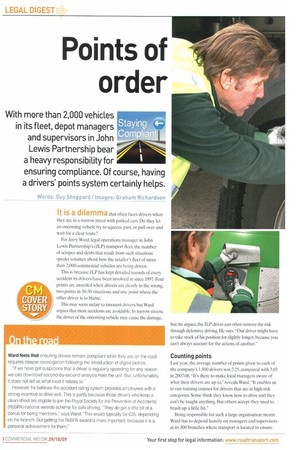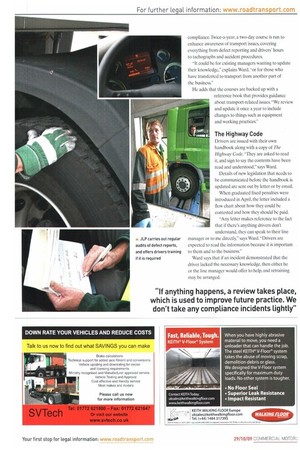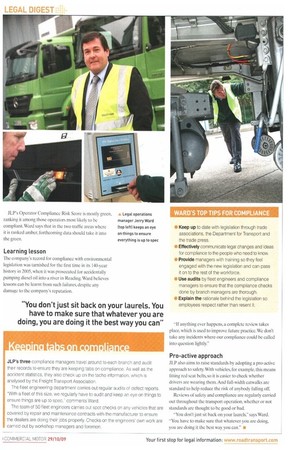Points of order
Page 28

Page 29

Page 30

If you've noticed an error in this article please click here to report it so we can fix it.
With more than 2,000 vehicles in its fleet, depot managers and supervisors in John Lewis Partnership bear a heavy responsibility for ensuring compliance. Of course, having a drivers' points system certainly helps.
Words: Guy Sheppard / Images: Graham Richardson It is a dilemma that often faces drivers when they are in a narrow street with parked cars. Do they let an oncoming vehicle try to squeeze past. or pull over and wait for a clear route?
For Jerry Ward, legal operations manager in John Lewis Partnership's (JLP) transport fleet, the number of scrapes and dents that result from such situations speaks volumes about how the retailer's fleet of more than 2,000 commercial vehicles are being driven.
This is because JLP has kept detailed records of every accident its drivers have been involved in since 1997 Four points arc awarded when drivers are clearly in the wrong, two points in 50-50 situations, and one point where the other driver is to blame.
This may seem unfair to innocent drivers, but Ward argues that most accidents are avoidable. In narrow streets, the driver of the oncoming vehicle may cause the damage. but, he argues, the JLP driver can often remove the risk through defensive driving. He says: "Our driver might have to take stock of his position for slightly longer, because you can't always account for the actions of another."
Counting points Last year, the average number of points given to each of the company's 1,500 drivers was 2.25, compared with 3.03 in 2007-08.-It's there to make local managers aware of what their drivers are up to," reveals Ward. "It enables us to run training courses for drivers that are in high-risk categories. Some think they know how to drive and they can't he taught anything. But others accept they need to brush up a little bit."
Being responsible for such a large organisation means Ward has to depend heavily on managers and supervisors at its 300 branches where transport is located to ensure compliance.Thice-a-year, a two-day course is run to enhance awareness of transport issues, covering everything from defect reporting and drivers' hours to tachographs and accident procedures.
-It could be for existing managers wanting to update their knowledge," explains Ward, "or for those who have transferred to transport from another part of the business."
He adds that the courses are backed up with a reference book that provides guidance about transport-related issues. "We review and update it once a year to include changes to things such as equipment and working practices."
The Highway Code Drivers are issued with their own handbook along with a copy of The Highway Code. "They are asked to read it, and sign to say the contents have been read and understood," says Ward.
Details of new legislation that needs to be communicated before the handbook is updated are sent out by letter or by email.
When graduated fixed penalties were introduced in April, the letter included a flow chart about how they could be contested and how they should be paid.
"Any letter makes reference to the fact that if there's anything drivers don't understand, they can speak to their line manager or to me directly," says Ward. "Drivers are expected to read the information because it is important to them and to the business."
Ward says that if an incident demonstrated that the driver lacked the necessary knowledge, then either he or the line manager would offer to help, and retraining may be arranged. JLP's Operator Compliance Risk Score is mostly green, ranking it among those operators most likely to be compliant. Ward says that in the two traffic areas where it is ranked amber, forthcoming data should take it into the green.
Learning Lesson
The company's record for compliance with environmental legislation was tarnished for the first time in its 140-year history in 2005, when it was prosecuted for accidentally pumping diesel oil into a river in Reading. Ward believes lessons can be learnt from such failures, despite any damage to the company's reputation.
;4 Keep up to date with legislation through trade associations, the Department for Transport and the trade press.
Effectively communicate legal changes and ideas for compliance to the people who need to know.
• Provide managers with training so they feel engaged with the new legislation and can pass it on to the rest of the workforce.
le Use audits by fleet engineers and compliance managers to ensure that the compliance checks done by branch managers are thorough.
• Explain the rationale behind the legislation so employees respect rather than resent it.
"If anything ever happens, a complete review takes place, which is used to improve future practice. We don't take any incidents where our compliance could be called into question lightly."
Pro-active approach
JLP also aims to raise standards by adopting a pro-active approach to safety. With vehicles, for example, this means fitting red seat belts, so it is easier to check whether drivers are wearing them. And full-width catwalks are standard to help reduce the risk of anybody falling oft Reviews of safety and compliance are regularly carried Out throughout the transport operation, whether or not standards are thought to be good or bad.
-You don't just sit back on your laurels," says Ward. -You have to make sure that whatever you are doing, you are doing it the best way you can." •








































































































































